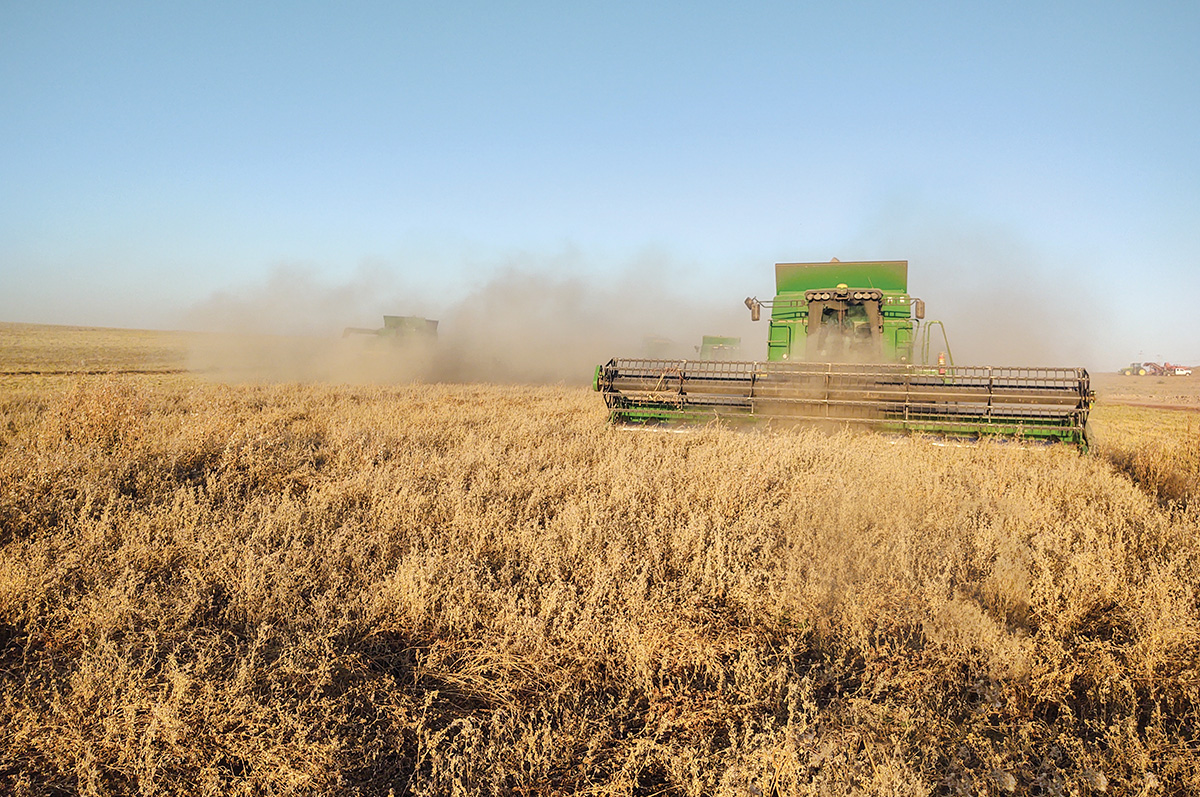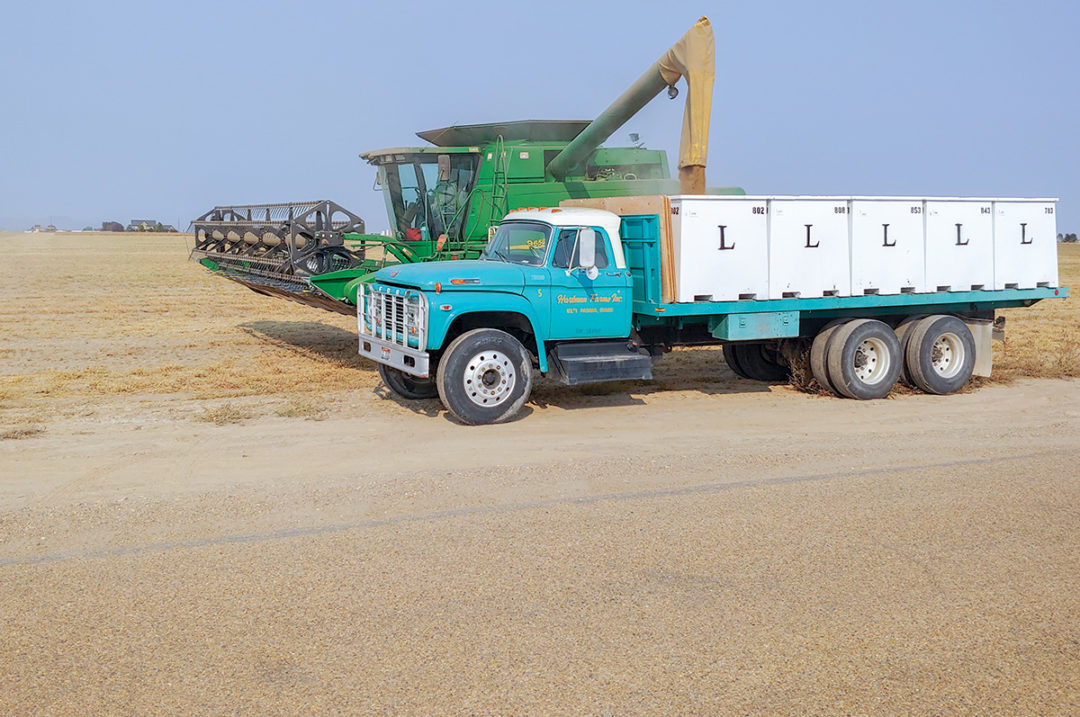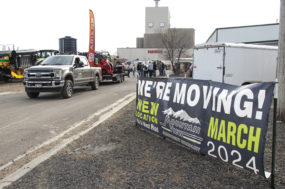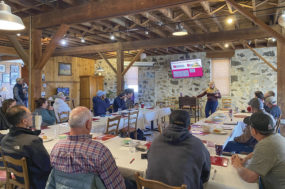Each year in the U.S., over 1.5 million acres are planted in new alfalfa seedings. If planted at 20 pounds per acre, that’s 30 million pounds of seed needed. Idaho doesn’t have a corner on raising alfalfa seed to satisfy this market, but most of the alfalfa seed grown in Idaho comes from western Idaho.
Alfalfa seed demand nationally has been declining gradually for the past 15 years, impacted largely by the dairy industry which moved to alternative feed sources (in part) as alfalfa prices climbed and freight rates rose. Nevertheless, alfalfa remains a cornerstone for the dairy and beef industries, and alfalfa seed growers continue to find a market for quality seed.
JP Lete, who grows alfalfa seed in Canyon County, says, “It seems weird that 20 years ago it seemed like the whole valley was alfalfa seed; now there’s hardly any.” But markets aren’t entirely to blame for the decline. “It’s a tough crop to grow because it’s sensitive to water, depends on bees, and during harvest it can rain or turn cold, and those things hurt yield,” he says.
Yield can be up to 2,000 pounds per acre, Lete says, but that doesn’t happen often. “About 1,000 pounds per acre of clean seed [1,200 pounds before cleaning] is more common.”
The lygus bug is also a bane to the industry and is hard to kill. Paul Rasgorshek, who farms south of Nampa, takes sweeps on his alfalfa seed fields two to three times per week. “There are some cleanup sprays you can use ahead of the bees, but when bees are in the field we use the soft chemistry products, spraying in the evenings until about midnight when the bees are in the bee boards located in the bee houses. Then by morning, when they’re active again, the chemistry is gone,” he says. “Anyone can do it [grow alfalfa seed] but it’s time-consuming and takes aggressive management. There are a lot of people who would just rather not farm that intensively.” It’s also a high-input crop with chemical treatments and leafcutter bees.
Pollination by alfalfa leafcutting bees or alkali bees is essential for seed set in alfalfa seed production. Many alfalfa seed growers purchase leafcutter bees from Canada. “Canadian bees come in full boards,” Rasgorshek says. “If we want to put the bees out June 1, then we start warming them up 21 days prior. It’s just timing, temperature and duration – like clockwork. Once they’re hatched, their purpose is to feed and reproduce. Feeding causes the pollination of the alfalfa seed. At the end of the year, we condition, sort, sell those bees and buy new bees for the next year. Some growers use their own bees, but local boards aren’t usually full boards and can carry over disease. We always like to start with clean bees. That’s just our program, but others use local bees and can handle them – it works for them.” There are also custom outfits who handle pollination for growers and offer other services.

Paul Rasgorshek defoliates the alfalfa before harvesting the seed to make combining easier. Photo provided by Paul Rasgorshek.
Rasgorshek; his wife, Marilyn; and youngest son, Kyle, grow 1,000-plus acres of alfalfa seed every season, along with additional acres in sugarbeets, garden beans, wheat, onion seed, peppermint and silage corn.
“I was raised on a philosophy of diversity, so that’s just the way I’ve continued our farm, but then,” he adds with a laugh, “I don’t have another life. Farming is my life and my hobby.”
Seed production for several crops seems to be a common denominator among alfalfa seed growers. Jeff Hartman farms near Parma and grows primarily vegetable seed on about 1,700 acres. This includes carrot seed, alfalfa seed, beans for seed (navy, black and garden beans) and hybrid seed corn.
“Once you have the infrastructure for seed, contacts for the processes, relationships and knowledge of leafcutter bees and incubation, being in the seed business makes sense. But it’s a steep barrier to entry,” Hartman says. “If you let that infrastructure and those relationships slip away from you for a year or two, it would be really difficult to get started again, especially in an industry that’s seeing some shrinkage.”
The alfalfa industry has seen some large shifts in the last two years, as Corteva, Pioneer and other larger companies consolidated or closed their alfalfa breeding programs. “A big seed company in Homedale owned by Corteva closed down,” says Lete, “and two years ago they were looking for more acreage. Then by fall they didn’t want new acres, and then two weeks later they were paying growers to tear it out. It’s hard to get info on what companies are doing.”
Alfalfa seed is grown under contract, and Rasgorshek says about two-thirds of his seed acreage is on a one-year contract – planted in fall (some in spring), then torn out after harvest. About one-third of his acreage is on a two-year or three-year contract. While the growers like a three-year contract, some varieties are only needed for one year of production. Seed companies speculate on what varieties are going to be needed and control inventories or varieties by adjusting contract length and acreages, so shorter contracts have become much more common in recent years.
“There just aren’t as many purchasing players in the game,” Hartman says. “Farming in general has consolidated, and this is just one more example of that.”
What neighboring farms can do to help seed production
Are other farmers the enemy of seed production? Bee Friendly Farming provides guidelines for farmers and growers to promote pollinator health on their lands.
What can you do to support seed growers and pollinators?
- Offer forage providing good nutrition for bees on at least 3% of land (includes cover crops if they’re left to bloom). Pollinators require year-round food and habitat.
- Provide blooms of different flowering plants throughout the growing season, especially early spring and late autumn (i.e., strips of flowering plants between orchard rows.)
- Offer clean water for bees. In large-scale commercial farming operations (where maybe a lot of the land is under pivot or mechanical irrigation), holding ponds, irrigation canals, etc., can help bee populations.
- Provide permanent habitat for nesting through features such as hedgerows, natural brush, buffer strips or bare ground.
- Develop your pest management system to take into consideration your neighboring farms’ needs and pollinator health (i.e., spraying during times of the day when bees are not active).






